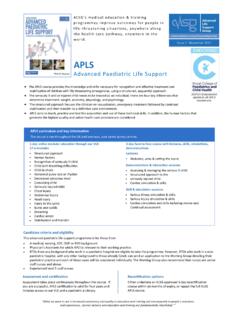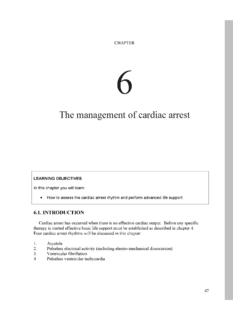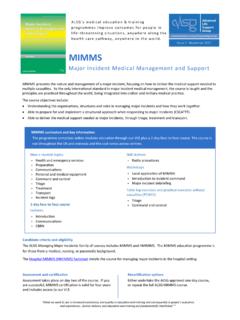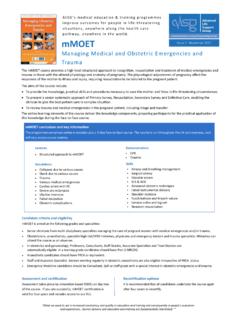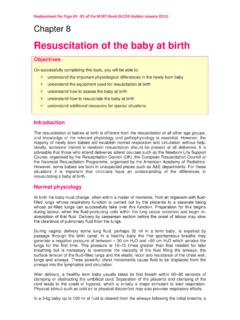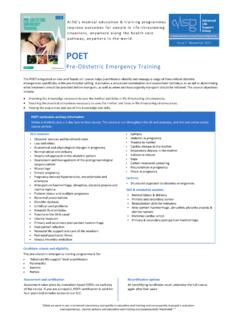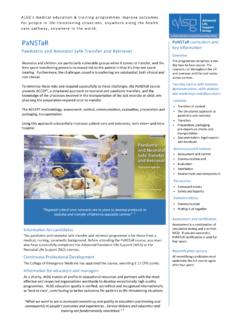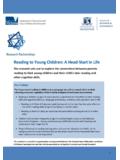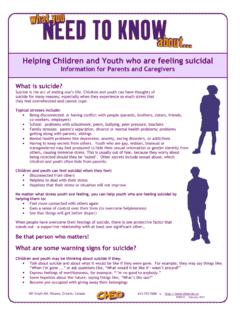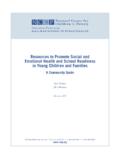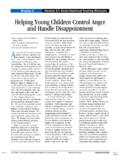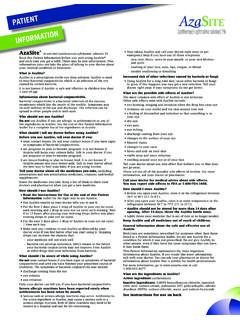Transcription of Basic life support - ALSG
1 Basic life support 21 CHAPTER 4 Basic life support LEARNING OBJECTIVES In this chapter, you will learn: How to assess the collapsed patient and perform Basic life support INTRODUCTION Paediatric Basic life support (BLS) is not simply a scaled-down version of that provided for adults, although, where possible, guidelines are the same for all ages to aid teaching and retention. Some of the techniques employed need to be varied according to the size of the child. A somewhat arti/cial line is generally drawn between infants (less than 1 year old) and children (between one year and puberty), and this chapter follows that approach.
2 The preponderance of hypoxic causes of paediatric cardiorespiratory arrest means that oxygen delivery rather than de/brillation is the critical step in children. This underlines the major differences with the adult algorithm. By applying the Basic techniques described, a single rescuer can support the vital respiratory and circulatory functions of a collapsed child with no equipment. Basic life support is the foundation on which advanced life support is built. Therefore it is essential that all advanced life support providers are pro/cient at Basic techniques, and that Basic life support 22 they are capable of ensuring that Basic support is provided continuously and well during resuscitation.
3 PRIMARY ASSESSMENT AND RESUSCITATION Once the child has been approached safely and a simple test for unresponsiveness has been carried out, assessment and treatment follow the familiar ABC pattern. The overall sequence of Basic life support in paediatric cardiopulmonary arrest is summarised in Figure Note: this guidance is for one or more health professionals. BLS guidance for lay people can be found in a later section. Figure The overall sequence of Basic life support in cardiopulmonary arrest (CPR = cardiopulmonary arrest) The SAFE approach Additional help should be summoned rapidly.
4 Furthermore, it is essential that the rescuer does not become a second victim, and that the child is removed from continuing danger as quickly as possible. These considerations should precede the initial airway assessment. They are particularly pertinent in an unfamiliar environment. Within a health care setting the likelihood of risk is decreased. The steps are summarised in Figure When more than one rescuer is present one starts BLS while another activates the Emergency Medical Services (EMS) system then returns to assist in the BLS effort.
5 If there is only one rescuer and no help has arrived after 1 minute of CPR then the rescuer must activate the EMS system himself or herself. In the case of a baby or small child the rescuer will probably be able to take the victim with him or her to a telephone whilst attempting to continue CPR on the way. Basic life support 23 Figure The SAFE approach Phone first In a few instances the sequence in the above paragraph is reversed. As previously described, in children, respiratory and circulatory causes of cardiac arrest predominate, and immediate respiratory and circulatory support as provided by the breaths and chest compressions of BLS can be life saving.
6 However, there are circumstances in which early de/brillation may be life saving, cardiac arrests caused by arrhythmia. On these occasions, where there is more than one rescuer, one may start BLS and another summon the EMS as above. But if there is a lone rescuer then he or she should activate the EMS system /rst and then start BLS afterwards. The clinical indication for EMS activation before BLS by a lone rescuer include: witnessed sudden collapse with no apparent preceding morbidity witnessed sudden collapse in a child with a known cardiac condition and in the absence of a known or suspected respiratory or circulatory cause of arrest.
7 The increasingly wide availability of public access defibrillation programmes with automatic external defibrillators (AEDs) may result in a better outcome for this small group. (see section ) Are you alright? The initial simple assessment of responsiveness consists of asking the child Are you alright? and gently applying painful stimulus to the child. Infants and very small children who cannot talk yet, and older children who are very scared, are unlikely to reply meaningfully, but may make some sound or open their eyes to the rescuer s voice or touch.
8 In cases associated with trauma, the neck and spine should be immobilised during this assessment. This can be achieved by a lone rescuer by placing one hand /rmly on the head. Airway (A) An obstructed airway may be the primary problem, and correction of the obstruction can result in recovery without further intervention. If a child is having dif/culty breathing, but is conscious, then transport to hospital should be arranged as quickly as possible. A child will often /nd the best position to maintain his or her own airway, and should not be forced to adopt a position that may be less comfortable.
9 Basic life support 24 Attempts to improve a partially maintained airway in an environment where immediate advanced support is not available can be dangerous, because total obstruction may occur. If the child is not breathing it may be because the airway has been blocked by the tongue s falling back and obstructing the pharynx. An attempt to open the airway should be made using the head tilt/chin lift manoeuvre. The rescuer places the hand nearest to the child s head on the forehead and applies pressure to tilt the head back gently. The desirable degrees of tilt are neutral, in the infant, and snif ng, in the child.
10 These are shown in Figures and Figure Chin lift in infants Figure Chin lift in children The /ngers of the other hand should then be placed under the chin and the chin should be lifted upwards. Care should be taken not to injure the soft tissue by gripping too hard. As this action can close the child s mouth, it may be necessary to use the thumb of the same hand to part the lips slightly. The patency of the airway should then be assessed. This is done by: LOOKing for chest and/or abdominal movement, LISTENing for breath sounds and FEELing for breath, and is best achieved by the rescuer placing his or her face above the child s, with the ear over Basic life support 25 the nose, the cheek over the mouth and the eyes looking along the line of the chest for up to 10 seconds.
